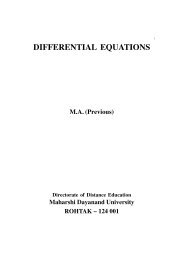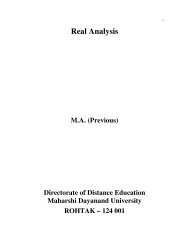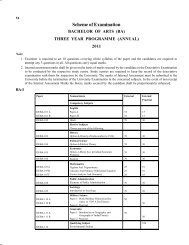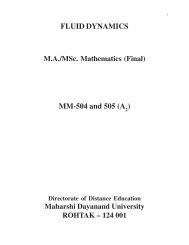Advanced Abstract Algebra - Maharshi Dayanand University, Rohtak
Advanced Abstract Algebra - Maharshi Dayanand University, Rohtak
Advanced Abstract Algebra - Maharshi Dayanand University, Rohtak
You also want an ePaper? Increase the reach of your titles
YUMPU automatically turns print PDFs into web optimized ePapers that Google loves.
UNIT-IV 99<br />
x 3 = (0, 0, 0, 1,…)<br />
. . . . . . . .. . . . . . .<br />
. . . . . . . .. . . . . . .<br />
x n = ( 0<br />
1<br />
,0,0,....,0 1, 0,….)<br />
4 2 43<br />
n terms<br />
Therefore for (a, 0, 0, ….) ∈ Q we have<br />
(a, 0, 0,…) x = (0, a, 0, …..)<br />
(a, 0, 0, …) x 2 = (0, 0, a, ….)<br />
. . . . . . . .. . . . . . . . . . . . . . .<br />
(a, 0, 0, ….) x n = ( 0<br />
1<br />
,0,0,....,0<br />
4 2 43<br />
, a, 0, ….) (ii)<br />
n terms<br />
If (a 0 , a 1 , .., a n , 0, …) be any arbitrary element of the polynomial ring P, then by (ii) we have<br />
(a 0 , a 1 , a 2 ,…., a n , 0, …) = (a 0 , 0, ….) + (0, a 1 ,…) + … + ( 0<br />
1<br />
,0,0,....,0<br />
4 2 43<br />
, a n , 0, ….)<br />
n terms<br />
= (a 0 , 0, …) + (a 1 , 0, ….) (0, 1, 0,…) + ….<br />
+ (a n , 0, 0,…) ( ( 0,0,0,...,0,0, 1, 0,…)<br />
1 4 2 4 43<br />
n terms<br />
= (a 0 , 0, …) + (a 1 , 0, 0, …) x + … + (a n , 0, 0,…) x n<br />
= a 0 + a 1 x + a n x n (by (i))<br />
Hence every element (a 0 , a 1 , a 2 ,…) of P can be denoted by<br />
a 0 + a 1 x + a 2 x 2 + … a n x n .<br />
* The numbers a 0 , a 1 ,…, a n are called coefficients of the polynomial. If the coefficient a n of x n is nonzero,<br />
then it is called leading coefficient of a 0 + a 1 x + … + a n x n .<br />
* A polynomial consisting of only one term a 0 is called constant polynomial.<br />
Example. If R is a commutative ring with unity, prove that R[x] is also a commutative ring with unity.<br />
Degree of Polynomial. Let f(x) = a 0 + a 1 x + … a n x n be a polynomial. If a n ≠ 0 , then n is called the<br />
degree of f(x). We denote it by deg f(x) = n.<br />
It is clear that degree of a constant polynomial is zero.<br />
If<br />
and<br />
f(x) = a 0 + a 1 x + a 2 x 2 + … a m x m , a m ≠ 0<br />
g(x) = b 0 + b 1 x + … b n x n , b n ≠ 0<br />
are two elements of R[x], then<br />
deg f(x) = m and deg g(x) = n and<br />
f(x) + g(x) = (a 0 + a 1 x + a 2 x 2 + … + a m x m ) + (b 0 +b 1 x+b 2 x 2 + … + b n x n )<br />
If m = n and a m + b n ≠ 0, then<br />
f(x) + g(x) = (a 0 + b 0 ) + (a 1 +b 1 )x + … + (a m + b m )x m<br />
Therefore in this case<br />
deg [f(x) + g(x)] = m.<br />
It is also clear that if m = n and a m + b m = 0 , then<br />
deg [f(x) + g(x)] < m.

















